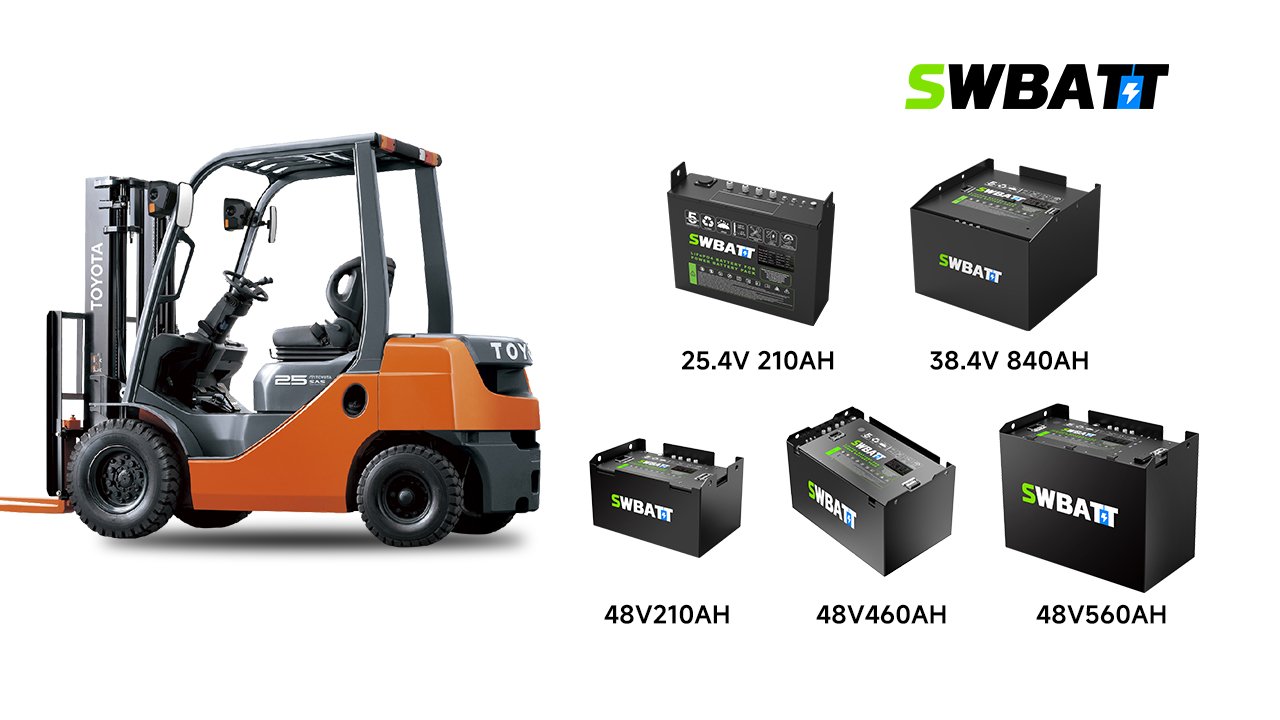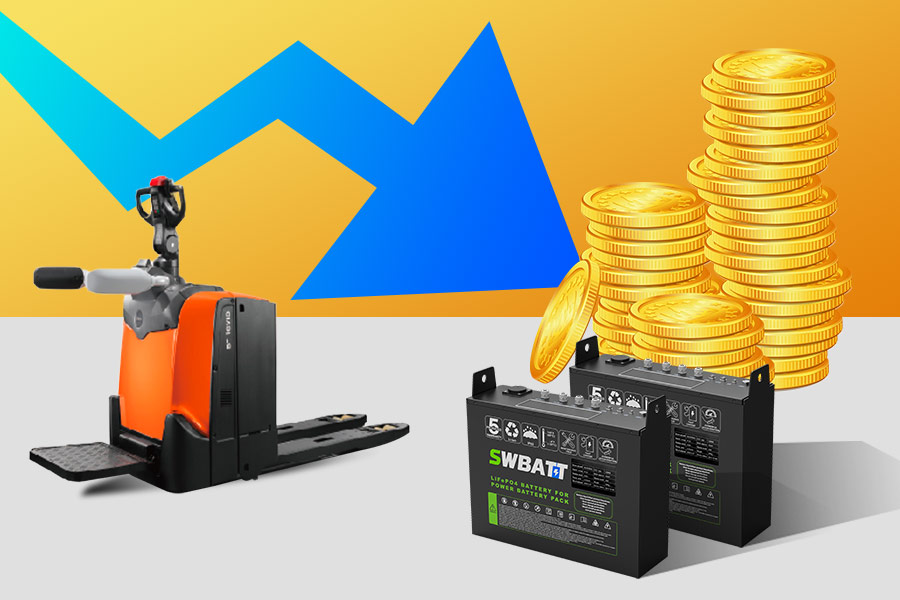The material handling industry is at a crossroads. The choice of forklift power – internal combustion (IC), lead-acid electric, or lithium forklift batteries electric – is no longer just about the upfront cost. It’s about long-term operational efficiency, sustainability, and adapting to a rapidly evolving market. As a manufacturer of lithium-ion battery packs, we see these shifts daily. But our goal here isn’t to push a single solution. It’s to provide you, the B2B decision-maker, with the comprehensive information you need to choose the right power source for your specific fleet and operational needs.
This guide will go beyond the usual product pitch. We’ll examine:
- The Big Picture: The evolving market trends in the forklift industry, including the shift from IC to electric and the rise of lithium-ion.
- The Head-to-Head: A detailed comparison of lead-acid and lithium-ion batteries, focusing on performance, cost, and environmental impact.
- The Product Landscape: This section provides an overview of the different types of lithium battery equipment available, helping you understand your options.
- The Decision-Making Framework: Practical advice on how to choose the right solution for your business.
We’re committed to transparency and providing value. We’ll back up our claims with authoritative data and link to reputable sources. Let’s dive in.
Market Trends: The Forklift Industry in Transition
Table of Contents
ToggleThe forklift market is undergoing a significant transformation, driven by several key factors:
- The Rise of Electric: Electric forklifts are rapidly gaining market share from traditional IC forklifts (powered by diesel, gasoline, or LPG). This shift is driven by:
- Stricter Emissions Regulations: Governments worldwide are imposing tighter regulations on emissions from IC engines, making electricity a more attractive option. [Source: EPA Regulations, EU Emissions Standards]
- Lower Operating Costs: While the initial investment in electric forklifts can be higher, the lower cost of electricity (compared to fuel) and reduced maintenance often result in a lower Total Cost of Ownership (TCO) over the long run.
- Improved Performance: Modern electric forklifts offer comparable (and sometimes superior) performance to IC models, with quieter operation and no exhaust fumes.
- Indoor/Outdoor Versatility: Electric forklifts are suitable for indoor and outdoor applications. In contrast, IC forklifts are often restricted to outdoor use due to emissions.
- The Lithium-ion Revolution: Lithium-ion batteries are rapidly replacing traditional lead-acid batteries within the electric forklift segment. This is due to:
- Superior Performance: Lithium-ion offers higher energy density, longer cycle life, faster charging, and virtually no maintenance.
- Increased Productivity: Opportunity charging and longer runtimes minimize downtime and maximize operational efficiency.
- Long-Term Cost Savings: Despite a higher upfront cost, lithium-ion often delivers a lower TCO due to a longer lifespan and reduced operating expenses.
Market Share Data (Illustrative Example):
| Forklift Type | 2020 Market Share (Estimated) | 2025 Projected Market Share (Estimated) | Source |
| IC Forklifts | 60% | 45% | Mordor Intelligence, [Industry Reports] |
| Electric Forklifts | 40% | 55% | Mordor Intelligence, [Industry Reports] |
| – Lead-Acid | 30% (of total electric) | 15% (of total electric) | [Industry Estimates], [Manufacturer Data] |
| – Lithium-ion | 10% (of total electric) | 40% (of total electric) | [Industry Estimates], [Manufacturer Data], MHI |
Note: These are illustrative figures. Actual market share varies by region and application. The trend, however, is clear: electric forklifts are gaining ground, and lithium-ion is rapidly becoming the preferred power source within the electric segment.
Let’s break down the key differences between lead-acid and lithium-ion batteries in a concise, data-driven format:
| Fitur | Lithium-Ion | Asam Timbal | Source(s) & Notes |
| Energy Density | High (100-265 Wh/kg) | Low (30-50 Wh/kg) | Battery University. More power, smaller package. |
| Cycle Life | 2,000-5,000+ cycles | 500-1,000 cycles | [Manufacturer Specs]. Lithium lasts much longer. |
| Charging | 1-3 hrs; Opportunity Charging | 8-10 hrs + Cool-down | [Industry Standards]. Faster charging = less downtime. |
| Maintenance | Virtually None | Regular Watering, Cleaning | OSHA, MHI. Significant time/cost savings. |
| Safety | Built-in BMS for Safety | Acid Spills, Gas Risk | UL, NFPA. BMS actively prevents problems. |
| Kisaran Suhu | Wider, Better in Cold | Performance Drops in Cold | [Manufacturer Specs]. Lithium performs well in varied climates. |
| Self-Discharge | Very Low (1-3%/month) | Higher (4-20%/month) | Battery University. Lithium holds charge longer. |
| Weight | Much Lighter | Heavier | [Manufacturer Specs]. Lighter = better maneuverability. |
| Environmental | Lower Overall Impact | Higher Impact (Lead, Acid) | EPA, [Sustainability Reports]. Lithium is more sustainable long-term. |
| Initial cost | High | Low | Lithium-ion battery initial price is more expensive than Lead-acid. |
The Total Cost of Ownership (TCO) Advantage
While the initial cost of lithium battery equipment is higher, the long-term TCO is often significantly lower. This is due to:
- Longer Lifespan: Lithium-ion batteries typically last 2-3 times longer (or more) than lead-acid batteries, eliminating the need for frequent replacements.
- Reduced Energy Costs: Lithium-ion is more efficient in charging and discharging, leading to lower electricity bills.
- Eliminated Maintenance: No watering, cleaning, or equalization saves time and labor costs.
- Increased Uptime: Faster charging and opportunity charging minimize downtime, boosting productivity.
- Reduced Battery Handling: No more swapping heavy lead-acid batteries.
Simplified TCO Example (3 Forklifts, 5 Years):
| Cost Item | Lithium-Ion (3 Units) | Lead-Acid (3 Units) | Notes |
| Initial Battery | $45,000 | $15,000 | Example prices; actual costs vary. |
| Replacements | $0 (Likely) | $30,000 | Lithium often outlasts the forklift. |
| Charging | $6,000 | $3,000 | Lithium may need higher-amp chargers, but fewer due to opportunity charging. |
| Electricity | $15,000 | $22,500 | Lithium is more energy-efficient. |
| Maintenance | $1,500 | $9,000 | Huge difference; lithium needs virtually no maintenance. |
| Labor (Handling) | $3,000 | $15,000 | Eliminating battery swaps saves significant labor. |
| Downtime | $3,000 | $9,000 | Faster charging, longer runtime = less downtime. |
| Total (5 Years) | $73,500 | $103,500 | Lithium offers substantial savings over the long haul. Run your own TCO analysis with your specific operational data. |
Discover Advanced Lithium Battery Solutions
Explore SWBATT‘s innovative LifePO4 batteries for electric vehicles, energy storage, and more. Tailored solutions to meet your energy needs with efficiency and sustainability.
Types of Lithium Forklift Batteries and Equipment
The term “lithium battery equipment” encompasses several components:
- Battery Packs: These are the core power source, typically available in various voltage and capacity configurations (e.g., 24V, 36V, 48V, 80V) to match different forklift models. Standard lithium-ion chemistries for forklifts include:
- Lithium Iron Phosphate (LFP): Known for its safety, long cycle life, and good thermal stability. This is a widespread choice for material handling applications.
- Lithium Nickel Manganese Cobalt Oxide (NMC): Offers higher energy density than LFP but may have a slightly shorter cycle life.
- Chargers: High-frequency chargers designed explicitly for lithium-ion batteries. These chargers often support opportunity charging, allowing for quick top-ups during breaks.
- Battery Management System (BMS): This is the battery’s “brain,” monitoring voltage, current, temperature, and state of charge. It protects the battery from overcharging, over-discharging, and other potential hazards. A sophisticated BMS is crucial for safety and performance.
- Connectors and Cables: Heavy-duty connectors and cables are designed to handle the high currents involved in forklift operation.
- Monitoring Systems (Optional): Some manufacturers offer advanced monitoring systems that provide real-time data on battery health, performance, and usage patterns. This data can be used to optimize fleet management and identify potential issues before they cause downtime.
Making the Right Choice: A Decision-Making Framework
Choosing the right forklift power solution requires a systematic approach:
- Assess Your Needs: Forklift Models: What types of forklifts do you operate? What are their voltage and capacity requirements?
- Application: What are the typical lift heights, load capacities, and operating environments?
- Duty Cycle: How many hours per day do your forklifts operate? Are there opportunities for charging during breaks?
- Infrastructure: What is the capacity of your existing electrical system? Will you need to upgrade your charging infrastructure?
- Calculate Your TCO: Develop a detailed TCO model that compares the long-term costs of different power options (IC, lead-acid, lithium-ion). Factor in all relevant costs, including initial purchase price, battery replacements, energy consumption, maintenance, labor, and downtime.
- Consider the Intangibles: Don’t forget to factor in the less quantifiable benefits, such as improved safety, increased productivity, and reduced environmental impact.
- Choose a Reputable Supplier: Select a manufacturer with a proven track record, a strong BMS, and comprehensive support services. Ask for references and case studies.
- Plan for the Future: Consider your long-term growth plans and choose a solution that can scale with your business.
FAQs (Concise Answers)
1. What is the ROI timeframe for switching to lithium forklift batteries, considering a mixed-use fleet (warehouse and occasional outdoor use)?
Answer: Typically, 2-4 years for a mixed-use fleet. Key factors are reduced energy costs (lithium’s efficiency), eliminated maintenance, longer battery life, opportunity charging, minimized downtime, and better cold-weather performance. A detailed, personalized TCO analysis is crucial.
2. How does a lithium-ion Battery Management System (BMS) specifically improve safety and extend battery life compared to lead-acid batteries, which do not have a BMS?
Answer: A BMS actively prevents problems such as lead-acid can’t. It provides:
- Overcharge/Over-Discharge Protection
- Over-Current Protection
- Temperature Monitoring & Control
- Cell Balancing (for even wear)
- Short Circuit Protection
- Provides operation data
This proactive control enhances safety and maximizes lifespan. Lead-acid relies solely on manual checks.
3. Beyond initial cost and TCO, what are the strategic advantages of adopting lithium forklift batteries for a large-scale distribution center with an aim for increased automation?
Answer: Lithium offers strategic advantages for automation-focused distribution centers:
- Seamless Integration: Better compatibility with AGVs and AS/RS due to BMS data.
- Scalability: Easily expand battery capacity as operations grow.
- Predictable Power: Consistent performance for automated systems.
- Minimized Downtime: Fast/opportunity charging is critical for high-throughput automation.
- Data-Driven Insights: BMS data optimizes fleet management.
- Simplified and unified power solution
It’s a future-proof investment aligning with automated logistics demands.
Conclusion
Choosing the correct forklift battery voltage is critical to performance, efficiency, and long-term costs. You can make informed choices that optimize your material handling operations by understanding the different voltage options, their advantages and disadvantages, and the key selection criteria. Always consult with SWBATT Forklift Lithiun Batteries manufacturer to determine the best solution for your needs and ensure proper integration with your existing or planned infrastructure.




